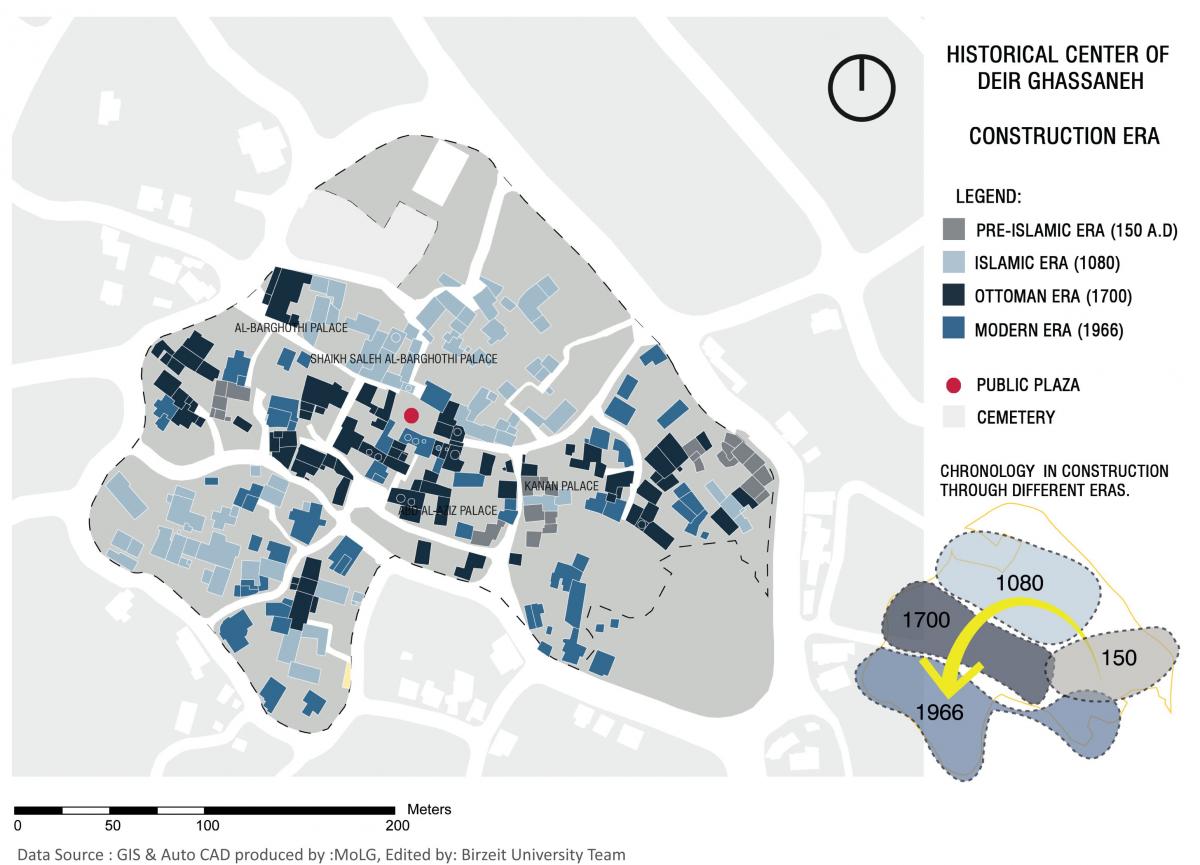Inventory of the Palestinian heritage
People have always felt the need to refer to
their history to identify themselves. Heritage is as such a collective property
which tells us this history; the history of people, cities and territories. Heritage
is a witness of our common identity, but also makes it possible for communities
to show their uniqueness to the world. As such, heritage makes it possible for
the present generation to understand their history and give a meaning to their current
life, but also to get an insight in the history and life of others. Modernization,
inevitable in every society, should therefore not overshadow the importance of
heritage as it is a vector of development and social stability, both for
present and future generations.[1]
By preserving the heritage, one preserves a
collective memory and identity. To valorize the heritage means to contribute to
a better mutual understanding among communities and as such to more recognition
and respect for the differences in the cultural identity. Preservation and
restoration of cultural heritage is therefore one of the crucial dimensions of
state- and nation building.
After all, heritage is not only a reflection of
identity, but also a powerful instrument in the economic and territorial
development of a community. When properly valorized and promoted, cultural
heritage could play an important role in tourism and tourism related
activities. Tourism is a potential source of many types of financial gain. One
can think of museum tickets, guided tours and visits, sale of handcrafts and
photos, but also of the hospitality industry, transportation and restaurant
services. Moreover, tourism is also a potential revenue for local governments
through taxes. As such, cultural heritage can be a catalyst for tourism and the
development of a city, region or country in general.
Therefore, national and local governments have
a major role to play in the protection of heritage. But choices need to be made
as it would be vain to aspire to preserve everything. Furthermore, preservation
cannot exist without development as otherwise it would lead to mummification.
The question however remains; which elements deserve more than others to be
preserved and to which level should the preservation be carried out?
The identification and inventorying of cultural
heritage is a first and fundamental step for gaining a general idea of the
richness and diversity of the cultural heritage in a city or territory.[2]
The scope of an inventory is to document the cultural heritage and make this
documentation accessible to all; national and local authorities, policy makers,
other stakeholders and the general public. Heritage inventories are an important tool for
decision makers to formulate an appropriate strategy for cultural heritage
conservation and management in urban contexts but could also be used to inform
and sensitize the general public about the assets of cultural heritage.
An inventory typically includes a wide range of
information on a building, site or open space such as location, boundary,
physical features, function, condition, architectural description, historic
evolution, and identification of values contributing to the cultural
significance. However, each inventory should be tailor-made to the researched
area, it should reflect and add information to previous inventories and pave
the way to get the predefined information necessary to make decisions on the
management, development or conservation of the heritage.
The case of the Palestinian Territory
The Palestinian Territory has a rich history which can be witnessed through a lot of historic sites, landscapes, archaeological remnants, vernacular buildings and compounds, etc. However, for various reasons, the value of this heritage has not always been recognized. The historic sites and areas are often abandoned due to a lack of interest; urbanization processes that do not consider traditional structures; and Palestinian laws for the protection of historic buildings that are ineffective. Most residents living in these areas are poor. They are often tenants, perceived as those who don’t have the means to move to modern cities or urban extensions, reinforcing the idea that historic centers and people living in them are backward. Due to lots of reasons a vast amount of heritage has already been lost and the still remaining heritage is threatened – and therefore decaying – by natural forces (wind, rain, vegetation, etc.).It is common that the preservation of historic centers, the protection of heritage and the valorization of traditions are seen as a barrier against the modernization and improvement of living conditions. Most people today don’t want to live in houses made out of mud, stone or wood, but rather aspire to live in the concrete and steel residences provided in the cities.
It should be the goal of all stakeholders in the heritage-field to change the sometimes negative perception with regards to ancient structures and to show the people the possibilities to adapt historic buildings to the needs and requirements of today and tomorrow, with respect for the historic values and local identity.
In light of this, Belgium and the Palestinian Authority through the Ministry of Local Government (MoLG) have agreed upon cooperating within the project called ‘Regeneration of Historic Centers’ (RHC) which aims at revitalizing Palestinian historic centers. The program supports the regeneration planning, practice and policy development in the Palestinian Territory and has three main result areas:
- Regeneration forms an integrated element of Municipal planning in targeted Local Government Clusters;
- The socio-economic regeneration of targeted historic centers is enhanced using a multi-dimensional approach; and
- Lessons learnt from the RHC project contribute to the evidence based policy framework and planning strategies for the Palestinian National Authority.
In order to develop the inventory a consultant (Mr. Corrado Minervini) was hired to develop the data framework and manual for the building construction assessment and inventory. Complementary with an effective inventorying tool, which provides the analysis of Historic Buildings in view of rehabilitation, a quick survey method was proposed in order to get an overall picture of the Historic Centers’ location, condition and value in the Palestinian territory.
Together with the consultant 3 successive stages were taken: the information retrieval phase where all existing data is collected, the inventory fieldwork and on-site investigation phase, and finally the recording of the collected data phase where collected data is entered into a GIS system in order to make the data available and readable for all. Moreover, in order to make the Ministry staff and the engineers of the targeted localities of the RHC program aware of the purpose of an inventory, and how to use it for decision making, several workshops and training activities were conducted.
But what’s next?
Documenting and inventorying the valuable heritage of a territory is only the first step in the right direction. After defining and documenting the heritage worth to be protected, a regulatory framework, including protective measures, needs to be set up to safeguard this valuable heritage. The integration of heritage in the development strategies and the creation of adapted and applicable regulatory tools and policies are essential for a sustainable management of heritage sites. These policies should be prepared based on urban and territorial planning documents, regional development schemes and local development plans.While the State remains in charge of protecting the national heritage through different policies, efficient protection and preservation cannot be accomplished without the establishment of operative partnerships at local level. As decentralization policies and processes continue to evolve (see the LGRDP program of BTC in the Palestinian Territory), the Local Authorities will increasingly have a greater role to play in the protection and management of the local cultural heritage. Communities are for example already responsible for issuing building permits for new constructions or building renovations and should be aware that these activities have a strong and lasting impact on the local heritage.[3]
However, very often municipalities do not have any skilled personnel in the field. Therefore it is crucial to strengthen the capacities of the staff of Local Government Units. This can be done through training, but also trough the establishment of strong alliances between government Ministries, National or professional institutions for Heritage Conservation (such as in the Palestinian case; Riwaq, CCHP, Welfare Association and Hebron Committee) and the local governments.
And finally, management tools should be developed as not only the conservation of heritage should be encouraged, but more importantly the regeneration and revitalization of historic sites should be aimed for. Only by protecting, regenerating and sustainably managing a historic site, heritage can be integrated and play its socio-economic role into the existing urban fabric.
[1] Cultural heritage and Local Development, A Guide for African Local Governments; UNESCO; 2006. [2] Cultural heritage and Local Development, A Guide for African Local Governments; UNESCO; 2006. [3] Cultural heritage and Local Development, A Guide for African Local Governments; p. 51; UNESCO; 2006.
Laatste nieuws van dit project
Geen nieuws

